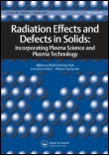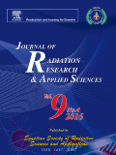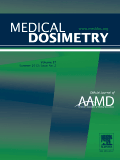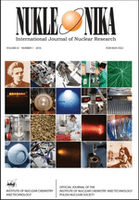
Radiation Effects and Defects in Solids
Scope & Guideline
Bridging Theory and Application in Radiation Research
Introduction
Aims and Scopes
- Radiation Effects on Materials:
Research exploring how various forms of radiation (e.g., gamma rays, ion beams) affect the structural, optical, and electrical properties of materials, including semiconductors, polymers, and glasses. - Dosimetry and Radiation Measurement:
Studies focused on developing and validating dosimetric methods and devices for accurate measurement of radiation doses in different contexts, including medical applications and environmental monitoring. - Radiation Shielding and Protection:
Investigations into materials and composites designed for effective radiation shielding, including the evaluation of their performance against gamma and neutron radiation. - Radiation-Induced Defects and Their Characterization:
Research on the mechanisms and implications of defects created in materials due to radiation exposure, utilizing techniques like electron paramagnetic resonance and thermoluminescence. - Applications in Medical Physics:
Exploration of the implications of radiation effects in medical technologies, including imaging, treatment planning, and patient safety, particularly in radiotherapy. - Novel Materials and Nanocomposites:
Synthesis and characterization of advanced materials, including nanocomposites and polymers, and their performance under radiation exposure.
Trending and Emerging
- Nanotechnology and Radiation Effects:
An increase in studies exploring the effects of radiation on nanomaterials and nanocomposites, highlighting their unique properties and applications in various fields, particularly in medical and energy sectors. - Advanced Radiation Shielding Materials:
Growing interest in the development and testing of novel materials for radiation shielding, particularly those that are lightweight, cost-effective, and environmentally friendly, is evident. - Automation and AI in Radiation Measurement:
Emerging research utilizing artificial intelligence and automation for dosimetry and radiation monitoring, indicating a shift towards more efficient and accurate measurement techniques. - Radiation Effects in Biomedical Applications:
A notable trend towards understanding radiation effects in biomedical contexts, particularly in the fields of cancer therapy and imaging, reflecting the increasing importance of radiation safety in healthcare. - Environmental and Health Impact Studies:
There is a rising focus on the environmental impact of radiation and its health implications, driven by public interest and regulatory demands regarding radiation safety and pollution. - Interdisciplinary Research Approaches:
An emerging trend of interdisciplinary studies that integrate physics, materials science, engineering, and biology to address complex problems related to radiation effects and applications.
Declining or Waning
- Traditional Radiation Dosimetry Techniques:
There has been a noticeable decrease in publications focused on conventional methods of radiation dosimetry, as research trends lean towards innovative and automated approaches. - Basic Studies of Radiation Effects without Application Context:
Papers solely focused on fundamental studies of radiation effects without practical applications or technological relevance are becoming less frequent, indicating a shift towards applied research. - Basic Characterization of Common Materials:
Research that primarily characterizes the radiation effects on standard materials (e.g., common metals or plastics) without exploring new materials or advanced composites is declining. - Localized Studies in Specific Geographic Areas:
Fewer publications are focusing on localized or region-specific studies regarding radiation exposure and effects, suggesting a trend towards more global or comprehensive studies. - Non-advanced Theoretical Studies:
Theoretical studies that do not incorporate advanced modeling or simulations, especially those missing contemporary computational techniques, are becoming less prevalent.
Similar Journals

Journal of Radiation Research and Applied Sciences
Exploring the frontiers of radiation research for a brighter future.Journal of Radiation Research and Applied Sciences, published by ELSEVIER, is a premier open-access journal since 2013, dedicated to advancing the understanding and application of radiation research in various fields. With an ISSN of 1687-8507, this journal serves as a vital resource for researchers, professionals, and students engaged in the study of the physical and biological effects of radiation, radiation physics, and its applications in medicine and industry. Its rigorous peer-review process ensures the dissemination of high-quality research that meets the growing demands for innovative solutions in radiation science. By offering comprehensive access options, the journal promotes an inclusive approach to sharing knowledge with the global community. The Journal of Radiation Research and Applied Sciences stands out as a key platform for scholarly communication, fostering advancements that impact both theory and practice in the rapidly evolving landscape of radiation research.

Nuclear Physics and Atomic Energy
Fostering collaboration in nuclear research.Nuclear Physics and Atomic Energy is a reputable open-access journal that focuses on the fields of nuclear physics and high-energy physics, providing a forum for researchers, professionals, and students to share their findings and advancements. Published by the Institute of Nuclear Research, National Academy of Sciences of Ukraine, this journal has been committed to disseminating knowledge since its inception in 2006, ensuring that scientific advancements remain accessible to a global audience. With an ISSN of 1818-331X and an E-ISSN of 2074-0565, the journal features a diverse array of articles that span the continued exploration and application of nuclear phenomena. Although currently categorized in the Q4 quartile for Nuclear and High Energy Physics in 2023, the journal is steadily working towards increasing its impact and engagement within the academic community. With a Scopus rank of #74 out of 87 in its category, it serves as a valuable resource for advancing crucial research in a vital scientific area. Researchers are encouraged to contribute their innovative studies to foster collaboration and knowledge sharing in this dynamic field.

MOMENTO-Revista de Fisica
Pioneering Research for a Dynamic Scientific CommunityMOMENTO-Revista de Fisica is a distinguished academic journal published by UNIV NACL COLOMBIA, FAC SCI, based in the vibrant academic landscape of Colombia. With an ISSN of 0121-4470 and an E-ISSN of 0121-4470, this Open Access journal has been a pivotal platform for disseminating research since its shift to Open Access in 2012. It primarily serves researchers, professionals, and students interested in a diverse range of fields such as Electronic, Optical and Magnetic Materials, Geophysics, History and Philosophy of Science, and Physical and Theoretical Chemistry. With an evolving focus that spans from 2019 to 2024, MOMENTO contributes significantly to the understanding of contemporary challenges and advancements in physics and its interdisciplinary applications. Despite its current Q4 rankings in several categories and Scopus rankings indicating growth areas, the journal plays a crucial role in nurturing a scholarly dialogue in less represented topics within the sciences. By bridging gaps in knowledge and fostering new ideas, MOMENTO-Revista de Fisica continues to attract authors and readers committed to pushing the boundaries of research.

NUCLEAR INSTRUMENTS & METHODS IN PHYSICS RESEARCH SECTION B-BEAM INTERACTIONS WITH MATERIALS AND ATOMS
Exploring the Frontiers of Beam InteractionsNUCLEAR INSTRUMENTS & METHODS IN PHYSICS RESEARCH SECTION B-BEAM INTERACTIONS WITH MATERIALS AND ATOMS, published by Elsevier, is a pivotal journal in the fields of nuclear and high energy physics as well as instrumentation. With an ISSN of 0168-583X and an E-ISSN of 1872-9584, this journal has been a significant contributor to the scientific community since its inception in 1983. Covering an extensive range of topics related to beam interactions with various materials and atoms, the journal serves as an essential resource for researchers, professionals, and students alike. It holds a respectable Q3 category ranking in both instrumentation and nuclear high energy physics as of 2023, indicating its relevance and quality within these domains. While the journal currently does not offer open access options, its invaluable findings are accessible through numerous academic libraries and institutions. With the publication's emphasis on fostering advancements in experimental techniques, instrumentation developments, and theoretical insights, it undoubtedly plays a crucial role in the ongoing progress and innovation in the field.

Medical Dosimetry
Advancing Precision in Radiation TherapyMedical Dosimetry is a distinguished journal published by Elsevier Science Inc, dedicated to the advancing field of medical dosimetry and its applications within oncology, radiology, and nuclear medicine. With its ISSN 0958-3947 and E-ISSN 1873-4022, this journal serves as a crucial resource for researchers and professionals aiming to enhance their understanding of radiation treatment planning and dosage calculations. Encompassing a comprehensive range of topics from clinical dosimetry to technology assessment, Medical Dosimetry has been disseminating significant findings since its establishment in 1988, contributing to the continuous development of best practices in patient care and safety. The journal currently holds a Q3 ranking in various categories, reflecting its pivotal role in the research community, while not currently offering open access, it remains an essential reference for scholars advancing the techniques utilized in medical imaging and treatment. By fostering a platform for high-quality research, it aims to bridge the gap between theoretical studies and clinical applications, making it a vital addition to any medical library.

Radiation Detection Technology and Methods
Pioneering Research for Enhanced Energy SecurityRadiation Detection Technology and Methods is a prominent academic journal published by Springer Singapore Pte Ltd, dedicated to advancing the field of nuclear and high-energy physics, as well as nuclear energy and engineering. Established in 2017, this journal provides a platform for the dissemination of pioneering research and innovative methodologies in radiation detection technology. As of 2023, it holds a commendable Q2 ranking in both the categories of Nuclear and High Energy Physics and Nuclear Energy and Engineering, underscoring its significance in fostering scholarly discourse within these vital fields. With ISSN 2509-9930 and E-ISSN 2509-9949, the journal aims to cater to a diverse audience of researchers, professionals, and students, emphasizing open access to knowledge. The journal's contributions are particularly crucial for those engaged in the development of safer and more efficient radiation detection techniques, ultimately bridging the gap between theory and practical applications in energy security and health physics. For researchers seeking a dedicated outlet for their work, Radiation Detection Technology and Methods represents an invaluable resource and an opportunity to influence the future of radiation science.

JOURNAL OF SYNCHROTRON RADIATION
Connecting Researchers in the World of Synchrotron RadiationJOURNAL OF SYNCHROTRON RADIATION, an esteemed publication by the International Union of Crystallography, is a leading journal in the fields of Instrumentation, Nuclear and High Energy Physics, and Radiation. With an impressive impact factor and categorized as a Q1 journal across multiple disciplines in 2023, it demonstrates a commitment to advancing knowledge and applications in synchrotron radiation science. The journal has embraced an Open Access model since 2022, providing unrestricted access to cutting-edge research for a global audience. Published bi-monthly, JOURNAL OF SYNCHROTRON RADIATION serves as a vital platform for researchers, professionals, and students seeking to engage with the latest findings, methodologies, and innovations in synchrotron techniques and technologies. With its rich history from 1996 to 2024, it is recognized as a key resource for those aiming to push the boundaries of material science, structural biology, and beyond.

NUKLEONIKA
Exploring the Depths of High Energy PhysicsNUKLEONIKA, published by SCIENDO, is a leading open access journal that has been serving the scientific community since its establishment in 1968. Focused on the domains of Nuclear and High Energy Physics, Condensed Matter Physics, and Nuclear Energy and Engineering, this journal provides a platform for innovative research and technological advancements in a variety of interdisciplinary fields. With an impressive history of publications and a current Q3 ranking in several categories, including Safety, Risk, Reliability and Quality and Waste Management and Disposal, NUKLEONIKA is recognized for its significant contributions to scientific discourse. Open access since 2014, the journal ensures that all research outputs are freely available, facilitating broad dissemination and accessibility for researchers, professionals, and students alike. Located in the heart of Warsaw, Poland, NUKLEONIKA aims to inspire collaborative efforts and foster a deeper understanding of complex physical phenomena and their practical implications.

JOURNAL OF RADIATION RESEARCH
Leading the charge in open-access radiation science.JOURNAL OF RADIATION RESEARCH, published by Oxford University Press, is a prominent peer-reviewed journal focusing on the diverse fields of radiation science, including health, toxicology, and radiology. Since its inception in 1960, this open-access journal has provided a critical platform for the dissemination of high-quality research, making it accessible to a global audience of researchers, professionals, and students. With a consistent track record, the journal holds an impressive impact factor and is categorized in Q2 of Radiation studies and Q3 in Health and Toxicology as per the 2023 rankings, reflecting its influential role in shaping contemporary discourse in the field. The journal also boasts notable rankings within Scopus, further underscoring its importance in advancing knowledge and innovations related to radiation. Spanning from 1960 to 2024, the JOURNAL OF RADIATION RESEARCH remains at the forefront of scientific exploration and is essential reading for anyone committed to advancing the understanding of radiation and its effects.

International Journal of Radiation Research
Illuminating Innovations in Radiology and ImagingThe International Journal of Radiation Research, published by the IJRR-IRANIAN JOURNAL RADIATION RES, serves as a critical platform for researchers and professionals in the fields of radiology, nuclear medicine, and imaging technology. Since its inception in 2003, this peer-reviewed, open-access journal has focused on disseminating significant findings and advancements, contributing to the global discourse on radiation research. With an ISSN of 2322-3243, the journal offers valuable insights into emerging technologies and methodologies, maintaining a commitment to enhancing the understanding and application of radiation in medical science. Although currently positioned in the Q4 category across its scopes, the journal strives to elevate its impact by promoting high-quality research and innovative practices. The journal is accessible to a wide audience and encourages submissions from scholars worldwide, directly supporting the advancement of knowledge in radiological and ultrasound technology. For those seeking to explore and contribute to this dynamic field, the International Journal of Radiation Research represents an invaluable resource.